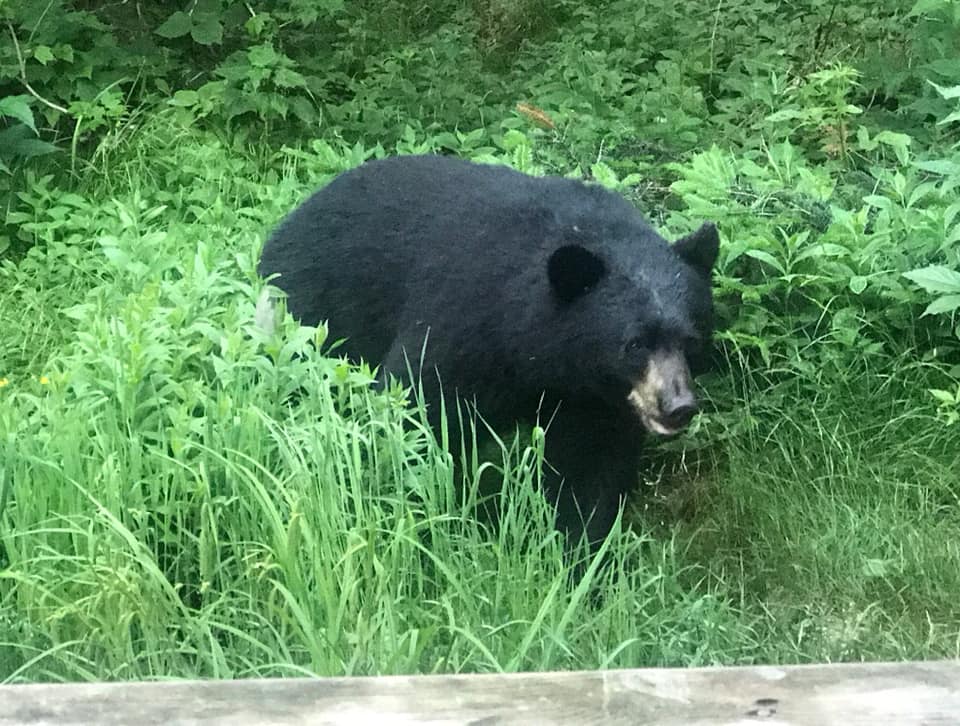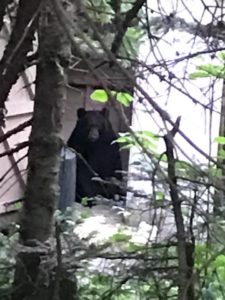
Vermont hiking trails have long been perceived as places where you don’t need to worry about bears. People hiked, camped, and cooked and stored food without concern. Times have changed, and with the increase in the black bear population, hiker behavior needs to change too.
In recent years we have experienced bear problems at several areas on the Long Trail, including Stony Brook Shelter, Montclair Glen Lodge, Hump Brook Tenting Area, Bamforth Ridge Shelter, and Journey’s End Shelter, to name a few.

In 2019, we had bear problems at Kid Gore, Goddard, and Stratton Pond Shelters. The bears at these locations did not react or show fear when yelled at or when stones were thrown in an attempt to scare them off. They got into several hikers’ food supplies, ripped apart a privy that had a moldy loaf of bread thrown in it, and sniffed into a shelter one night—leaving only after a startled hiker smacked the bear in the head with a trekking pole.
Most black bears are wary of humans and shy away, but food-conditioned bears are potentially threatening to humans, and, if determined to be a nuisance, may be shot. This is the last thing we want, so before you head into the backcountry, take time to educate yourself about bear behavior and avoid putting them, yourself, or future hikers at risk.
GMC staff work with the Vermont Fish and Wildlife Department and wildlife officials on the Green Mountain National Forest to address current bear issues and plan for improvements at the shelters and other overnight sites. We ask that you help by being prepared and taking some simple precautions.
How to Store Food in Bear Country
When you step into a shelter, you might see an inverted tin can tied to a string that hangs from the ceiling. These “mouse hangers” are affixed by hikers, not GMC staff. They are intended to suspend food bags and backpacks to keep them safe from mice and other pesky critters looking for goodies and salt. But guess who is also interested in your food, and can reach those hangers? Bears. With the change in bear activity and incidents on the trail, we ask that you remove the strings and cans from the shelters (and don’t add new ones). This will be a good first step to detracting bear visits to the shelters.
How, then, do you secure your food? As of summer 2019, one of these options is required in the Green Mountain National Forest. Here are some options, from most secure to least secure:
- If a bear box is available at a designated overnight site, use it. Food and other scented items (toothpaste, deodorant, chapstick, sunscreen, etc) should be stored away. Make sure the box is closed and latched. See the list of all overnight sights with bear boxes on the Long Trail and Appalachian Trail.
- GMC strongly recommends that hikers carry a bear-resistant food storage container. There are a variety of them available; some are more effective than others. Know how to use yours correctly, leave it closed and locked, and stash it at least 100 yards from your—or anyone else’s—shelter. Don’t put it near a cliff or water source or a bear might bat it over the ledge or into the water. Check the Interagency Grizzly Bear Committee website for approved personal food storage options.
- Hang a bear bag from a tree limb. This is very often done incorrectly and finding a suitable branch is difficult in our dense forests. However, if it is your only option, make sure food bags are hung 100 yards away from the shelter and all tents in the area.
*A Food Storage Closure Order for the entire Green Mountain National Forest (GMNF) aims to minimize black bear and human encounters and interactions. The order specifies proper food storage and prohibits leaving food or refuse on National Forest system lands in Vermont. The Order was issued to provide for visitor safety and the conservation of bears. Find more information in the press release; this order is still in effect (summer, 2021).
If a bear is successful at getting into your food, please report it to GMC and Vermont Fish and Wildlife. If you see a bear in the vicinity of a designated campsite on the Long Trail, please notify GMC.

How Humans Should Behave in Bear Country
- As the bear at Goddard Shelter who tore apart the privy demonstrated, bears are not particular about where discarded food is. Do not throw food or trash into the privy or composting bins. (Also, our caretakers have the unpleasant task of removing these items from the waste bin later.)
- Pack out all garbage and food scraps and do not leave any trash in the bear boxes. There are no trash cans on the trail, and there is no one to collect your trash. If you see trash in the bear boxes already, please consider packing some out with your own garbage.
- While Trail Magic can be a wonderful and welcome gesture, do not leave extra food in the shelters or unattended alongside the trail. The bear at Montclair Glen Lodge busted the door open and went inside searching for some magic.
- Cook meals away from your tent or shelter, and do not eat in your tent or shelter. Keep tasty smells away from where you sleep. Secure food as listed above.
- Do not feed or approach bears. Intentionally feeding bears is illegal.
- If you encounter a bear in the trail, follow these recommendations from the Vermont Fish and Wildlife Department:
- When the bear is unaware of your presence you should:
- Quietly back away from the bear and leave the area.
- DO NOT approach the bear.
- When the bear is aware of your presence and is uninterested you should:
- Quietly back away from the bear and leave the area.
- DO NOT approach the bear.
- When the bear is curious and continues to look in your direction, smells the air, or slowly approaches you should:
- Talk in a calm voice while slowly backing away from the bear.
- DO NOT approach the bear. If the bear is defensive it may:
- Make vocalizations which can include huffing and jaw popping.
- Retreat up a tree.
- Swat at the ground or tree.
- Lower its head with ears flattened, and sways back and forth.
- When the bear is defensive you should:
- Begin repeating “Hey bear” in a calm voice.
- Back away and leave the area.
- If the bear continues to be defensive or becomes aggressive it may:
- Approach you.
- Begin to follow you.
- Charge you.
- When the bear is aggressive you should:
- Make yourself look bigger by putting your arms above your head. Continue to repeat “Hey bear” in a calm voice. Back away and leave the area.
- If it continues to follow you, stand your ground, make yourself look bigger, shout at the bear, threaten the bear with whatever is at hand (bang a stick on the ground, clap your hands), and prepare to use bear pepper spray if it is available. Back away and leave the area.
- If charged, stand your ground, talk to the bear in a calm voice and use bear pepper spray when available. If the bear makes contact with you, fight back using anything you have (e.g. stick, binoculars, etc.).
- When the bear is unaware of your presence you should:
For even more information about bear behavior and what to do in certain situations, check out this FAQ.
GMC’s Bear Plans
In 2019, the bear that tore apart the privy at Goddard Shelter was a concerning incident. In response to this, GMC immediately installed a bear box for secure food storage for hikers, reinforced the privy door to make it harder for a bear to enter into the privy, picked up all trash within 150 feet of the shelter, and placed informational signs at the shelter, privy, and bear box on the importance of properly storing food, keeping a clean camp, and how to handle an interested bear. Since then, this particular bear has taken two backpacks from hikers and destroyed two tents looking for food. Goddard Shelter was closed while game wardens from Vermont Fish and Wildlife tracked down and shot the bear. It is now reopened, but please continue to practice safe food storage as outlined so we can avoid this outcome in the future.
GMC evaluates food storage options on a site-by-site basis and intends to create secure, efficient, and easy-to-operate food storage systems for most overnight sites. In the meantime, human behavior will determine whether Vermont’s black bears become “problem bears” or remain the shy and elusive creatures they started as. Please do your best to be part of the solution and to educate others on bear safety. This will create a safer trail for hikers and a safer environment for bears.
GMNF Food Storage Closure Order
The following acts are prohibited on the Green Mountain National Forest:
- Except while being consumed, all food, food containers and refuse shall be stored in a closed motor vehicle or suspended at least twelve (12) feet above the ground and not less than six (6) feet horizontally from any object. Bear boxes and bear canisters designed specifically for food and/or refuse storage are acceptable.
- All refuse containing food materials or containers shall be deposited in receptacles provided for that purpose, removed from the Green Mountain National Forest to be disposed of properly, or stored in the manner prescribed for food in #1 above (36 CFR 261.58(cc)).
We have had many questions about whether Ursacks are allowed with the GMNF order. Ursacks are currently acceptable under the Food Storage Closure Order, but as with any newer device or technology, they could be unacceptable in the future if GMNF sees issues with them. We recommend that they be used in conjunction with the odor-proof OPSaks recommended by Ursack.
This article was contributed to by Jocelyn Hebert, Keegan Tierney, Kristin McLane, and Lorne Currier.



















It is a management problem at the State Level.
Hikers need to be educated on how to secure their food. The GMC is working on doing just that! It is not up to the state, it is up to the hiking community!
After this article was published, game Wardens euthanized the bear that had been stealing food at the Goddard Shelter. Please use the bear boxes when available at shelters or hang your food so this does not have to happen again to a future bear.
It is also a management issue in terms of hikers behavior.
UPDATE 7/15/19:
The bear’s behavior continued to escalate and it had to be euthanized by game wardens. Goddard Shelter is now reopened. Please continue to practice safe food storage as outlined above so we can avoid this outcome in the future.
All that support for hikers; bear boxes, privy, shelter, signage, and guidelines.
Yet some hikers felt the system in place didn’t apply to them and it cost a bear its life.
UPDATE 7/16/19:
There is now also a bear box at Stratton Pond Shelter and the above list has been updated.
Any activity at the Stratton pond tenting area? Coming in August
We have not heard of any bear activity at the tenting area but there has been activity at the shelter so a bear is in the area. There is a new bear box over at the shelter. We recommend using the bear box where available, or using a bear can or hanging your food, anywhere on the trail regardless of bear activity. Bears live in the woods all over Vermont, whether we see them or not.
Vermont and Many States allow baiting with donuts and tons junk food for hunting/killing bears, now we wonder how and why bears become acclimated to people!
it is and has been illegal to bait bears at all, or feed them intentionally or unintentionally.
though the state has decided that they want more bears, and managed their population to that end, now there are more dangerous encounters…. why do we need so many bears?
It seems like a bear hunt is in order. The simple reason that there are more bear encounters is not human behavior. It’s the fact that there are more bears. The bears were fruitful and multiplied. Without a hunt the bear population will grow, human encounters will become more frequent and eventually a human will be injured or killed. All the bear boxes in the world can’t prevent this it will only delay it.